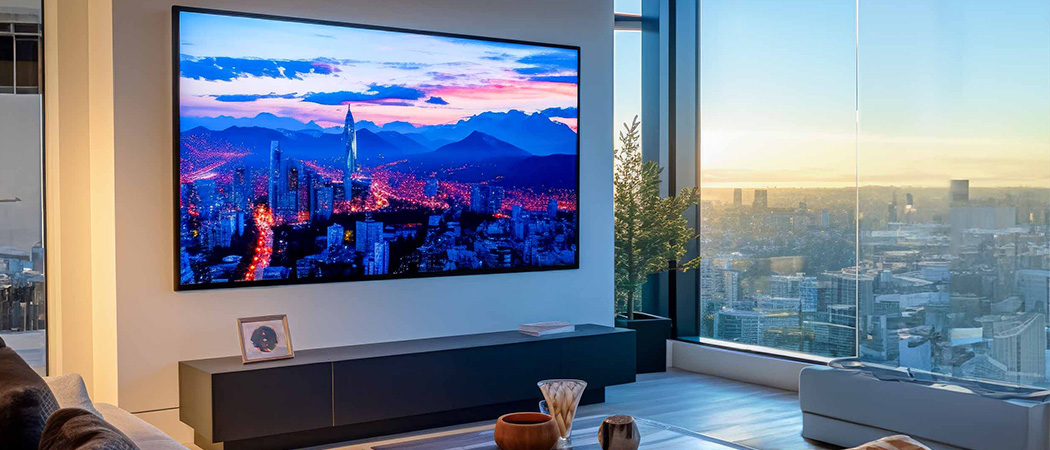
Active LED displays are becoming increasingly popular in residential settings, offering both functional and aesthetic benefits. In homes, these displays go beyond just entertainment purposes—they are integrated into modern smart home systems, serve as decorative elements, and enhance communication and convenience. Here’s how LED displays can be used in residential environments:
Key Applications of Active LED Displays in Residences
1. Home Entertainment Systems
High-Definition TVs and Home Theaters: LED displays are the core of modern home entertainment systems, offering ultra-high-definition visuals with vibrant colors and deep contrasts. Homeowners use large LED screens for watching movies, gaming, and streaming content, creating a cinema-like experience in living rooms or dedicated home theater spaces.
Smart TV Integration: Smart LED TVs allow homeowners to access streaming platforms, browse the internet, and control other smart devices directly from the display. They are often voice-activated and integrate seamlessly with home automation systems.
2. Digital Art Displays
Decorative LED Art Panels: LED displays can be used to showcase digital artwork or photography, serving as a dynamic element of interior design. Homeowners can change the displayed art regularly to suit their mood or the season, adding versatility to their decor.
Interactive Art Installations: Some residences incorporate LED screens into walls or standalone installations that interact with ambient lighting, music, or touch, creating immersive and dynamic environments.
3. Home Automation and Control Panels
Smart Home Hubs: LED touch screens are commonly used as control panels for home automation systems. These panels allow homeowners to control lighting, heating, security cameras, and entertainment systems from a single interface. Some panels even allow remote monitoring and control via smartphones or tablets.
Voice-Activated Displays: Integrated with voice assistants like Amazon Alexa or Google Assistant, LED displays show visual feedback for commands such as setting the thermostat, checking the weather, or controlling smart appliances.
4. Security and Surveillance
Real-Time Security Feeds: LED displays are used in residential security systems to show real-time feeds from security cameras placed around the home. These displays allow homeowners to monitor entrances, driveways, and other key areas of their property, enhancing safety and security.
Smart Doorbell Displays: LED screens integrated with smart doorbell systems display video feeds of visitors at the front door. Homeowners can communicate with visitors remotely and monitor the feed in real-time from inside the house or via mobile apps.
5. Home Office and Productivity Displays
Video Conferencing: With the rise of remote work, LED displays are commonly used for video conferencing in home offices. These high-definition screens offer clear visuals for virtual meetings, making them ideal for professionals who need to stay connected with teams or clients.
Digital Whiteboards: Interactive LED displays are sometimes installed in home offices as digital whiteboards, allowing professionals or students to brainstorm, write notes, and collaborate in real time during virtual meetings or study sessions.
6. Home Gym and Fitness Displays
Interactive Workout Displays: LED screens in home gyms or fitness areas provide guided workout sessions, yoga classes, or virtual trainers. These displays often integrate with fitness apps, allowing users to track progress, view real-time metrics like heart rate and calories burned, and participate in interactive or live-streamed workouts.
Fitness Mirrors: Some fitness equipment manufacturers offer “smart mirrors” that use LED technology to provide a reflective surface that also functions as a display for fitness content. These mirrors show virtual trainers, workout metrics, and offer a sleek, space-saving solution for home workouts.
7. Lighting and Ambiance
LED Wall Panels and Light Displays: Some homes use LED wall panels that serve as both a light source and a decorative element. These panels can change color, brightness, and pattern based on mood, time of day, or music. They are particularly popular in modern, tech-forward residences.
Ambient Lighting Control: LED displays integrated with smart lighting systems allow homeowners to control ambient lighting throughout the home, adjusting colors and brightness levels to create the perfect environment for relaxation, entertaining, or sleep.
8. Family Communication Boards
Digital Message Boards: In kitchens or common areas, LED displays serve as digital family message boards where family members can leave notes, reminders, or to-do lists. These screens can sync with family calendars or digital assistants to provide updates on schedules, chores, or shopping lists.
Smart Mirrors with Displays: Some modern homes include smart mirrors with integrated LED displays. These mirrors provide functionality beyond reflection by displaying time, weather updates, news headlines, or important family reminders.
9. Outdoor LED Displays
Digital Signage for Outdoor Spaces: Some high-end residences use LED displays in outdoor areas such as patios, pools, or gardens. These outdoor displays are designed to withstand weather conditions and can be used for entertainment (e.g., outdoor movie nights), ambiance, or digital art.
Security Alerts and Updates: LED displays integrated with home security systems can provide real-time alerts and updates about the status of gates, sensors, or other outdoor security devices. These displays are often placed at key entry points or outdoor control panels.
10. Energy Monitoring and Smart Home Integration
Energy Usage Displays: LED screens integrated with smart meters allow homeowners to monitor energy consumption in real time. These displays provide detailed insights into power usage, helping residents reduce energy waste and manage their home’s eco-footprint.
Sustainability Integration: LED displays connected to solar power systems or smart energy grids show the home’s energy production and consumption patterns, enabling better control over renewable energy use and sustainability efforts.
Benefits of Active LED Displays in Residences
Enhanced Convenience: LED displays in home automation systems allow residents to control multiple aspects of their home—lighting, climate, security, and entertainment—through an easy-to-use, centralized interface. This improves convenience and streamlines daily tasks.
Customization and Personalization: From digital art to personalized lighting, LED displays offer endless possibilities for customizing home environments. Homeowners can change content and ambiance at will, making their living spaces more versatile and adaptable.
Energy Efficiency: LED technology is energy-efficient, consuming less power than traditional lighting and display systems. This not only reduces electricity costs but also contributes to the home’s overall energy efficiency, especially when paired with smart energy management systems.
Modern Aesthetic Appeal: LED displays offer a sleek and modern look that enhances the design of contemporary homes. Whether used for entertainment, decoration, or functionality, LED screens fit seamlessly into high-tech, minimalistic, or futuristic interior designs.
Real-Time Information: In residences equipped with smart home systems, LED displays provide real-time information about energy use, security, and even the health of appliances. This allows homeowners to make informed decisions about managing their home efficiently.
Improved Safety and Security: LED displays enhance home security by providing real-time video feeds from security cameras, alerts, and other visual cues that improve the monitoring and management of residential safety systems.
Entertainment and Family Engagement: Whether used for family movie nights or interactive art displays, LED screens provide an engaging form of entertainment that brings family members together. The dynamic and versatile nature of these displays makes them suitable for multiple activities and purposes.
Conclusion
In modern residences, Active LED displays are more than just tools for entertainment—they are integral to the smart home ecosystem. From providing a hub for home automation and enhancing security to creating interactive and dynamic decor, LED displays improve convenience, safety, and lifestyle customization. With the growing integration of smart technologies in homes, LED displays will continue to evolve as essential components of future residential living.
Products
Agency
Get In Touch
- Rajkot Gujarat India.
- +91 9974 601 712
- info@sohamimpex.co.in
Follow Us
Soham Impex has successfully built a presence in the Active LED Display for Advertising and Branding Purposes. We stand out with the help of our comprehensive LED design and build, catered to clients Pan-India.
Follow Us
Get In Touch
- +91 9824201712
- info@sohamimpex.co.in
- 150ft. Ring Road, Rajkot Gujarat India.


